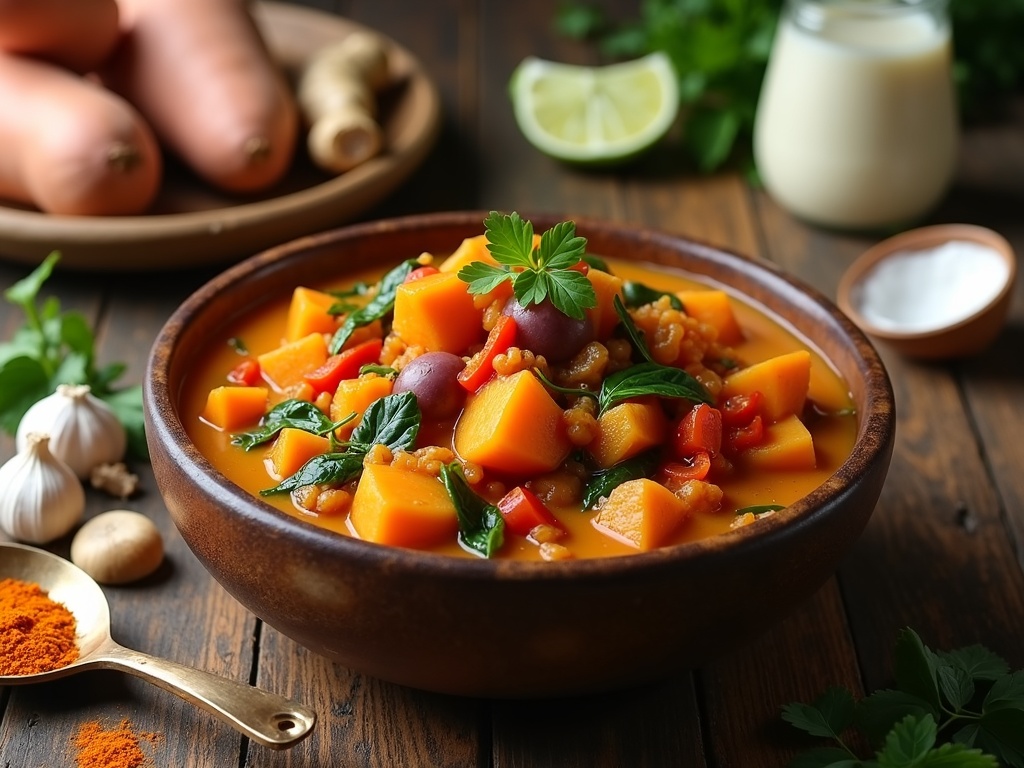Sweet potato curry packs a nutritional punch while delighting taste buds. This vibrant dish delivers an impressive 438% of daily vitamin A needs, 4g of protein, and 16% of daily fiber in a single serving. Its moderate glycemic index (44-61) helps manage blood sugar levels better than many other starchy options.
I love how sweet potatoes soak up curry flavors while adding their own creamy texture and gentle sweetness. The combination creates a satisfying meal that supports health without sacrificing taste.
Find In This Article
Key Takeaways
- Sweet potatoes provide 438% of daily vitamin A requirements and contain about 4g of protein and 16% of daily fiber needs in a single serving.
- The moderate glycemic index (44-61) makes sweet potato curry suitable for blood sugar management compared to other starchy foods.
- Sweet potato curry can be prepared in under 30 minutes with simple ingredients like coconut milk, onions, garlic, ginger, and curry powder.
- Regional variations exist across South India, the Caribbean, and Southeast Asia, each adding unique spices and techniques.
- The dish improves with time as flavors meld, making it perfect for meal prep with leftovers lasting 3-4 days refrigerated or up to 3 months frozen.
The Health Power of Sweet Potatoes
Sweet potatoes pack an impressive nutritional punch that makes them a standout ingredient in any vegetable curry. These vibrant root vegetables aren’t just delicious—they’re nutritional powerhouses that can transform your health while satisfying your taste buds.
Impressive Nutritional Profile
A medium sweet potato delivers an astonishing 438% of your daily vitamin A requirement. This nutrient plays a vital role in maintaining eye health and supporting your immune system. What’s even more impressive is that sweet potatoes contain about 4g of protein and meet 16% of your daily fiber needs, making them surprisingly filling despite their sweet flavor.
If you’re watching your fat intake, sweet potatoes have you covered. With just 0.1g of fat per serving, they’re an excellent heart-healthy option that fits perfectly into balanced diets. They’re particularly beneficial when incorporated into a dahl recipe for a complete protein-rich meal.
When comparing sweet potatoes to their white counterparts, the nutritional advantages become clear. Sweet potatoes contain higher levels of vitamins A, C, and manganese than white potatoes. Calorie-wise, they provide 86 calories per 100g serving compared to white potatoes’ 77 calories—a small difference considering the significant nutritional benefits.
Blood Sugar Management and Antioxidant Power
One of the lesser-known benefits of sweet potatoes is their moderate glycemic index, which ranges between 44-61. This makes them a smart choice for blood sugar management compared to many other starchy foods. I’ve found they pair beautifully with spices in a cauliflower curry to create a satisfying meal that won’t spike your glucose levels.
The antioxidant content in sweet potatoes is truly exceptional, especially in purple varieties. These compounds help fight oxidative stress and inflammation in your body. The rich, vibrant colors signal the presence of these beneficial compounds—the deeper the hue, the higher the antioxidant content.
Sweet potatoes make an excellent base for curry dishes because they absorb flavors while maintaining their nutritional integrity during cooking. I often add them to sambar recipes for added nutritional value and natural sweetness that balances the tangy tamarind.
For a complete meal that maximizes the health benefits of sweet potatoes, consider pairing your sweet potato curry with a fragrant pulao recipe. The combination provides complementary proteins and creates a balanced meal that’s as nutritious as it is satisfying.
The versatility of sweet potatoes extends beyond their nutritional profile. Their natural sweetness means you can often reduce added sugars in recipes, and their creamy texture adds body to curries without needing heavy cream or excess fats.
I’ve noticed that roasting sweet potatoes before adding them to curry intensifies their flavor and caramelizes their natural sugars, creating deeper, more complex flavors while preserving their nutritional benefits.
With their impressive vitamin content, low fat profile, and moderate glycemic index, sweet potatoes truly earn their place as a superfood worthy of featuring in your next curry creation. Their nutritional density transforms an ordinary meal into a health-boosting experience without sacrificing flavor or satisfaction.
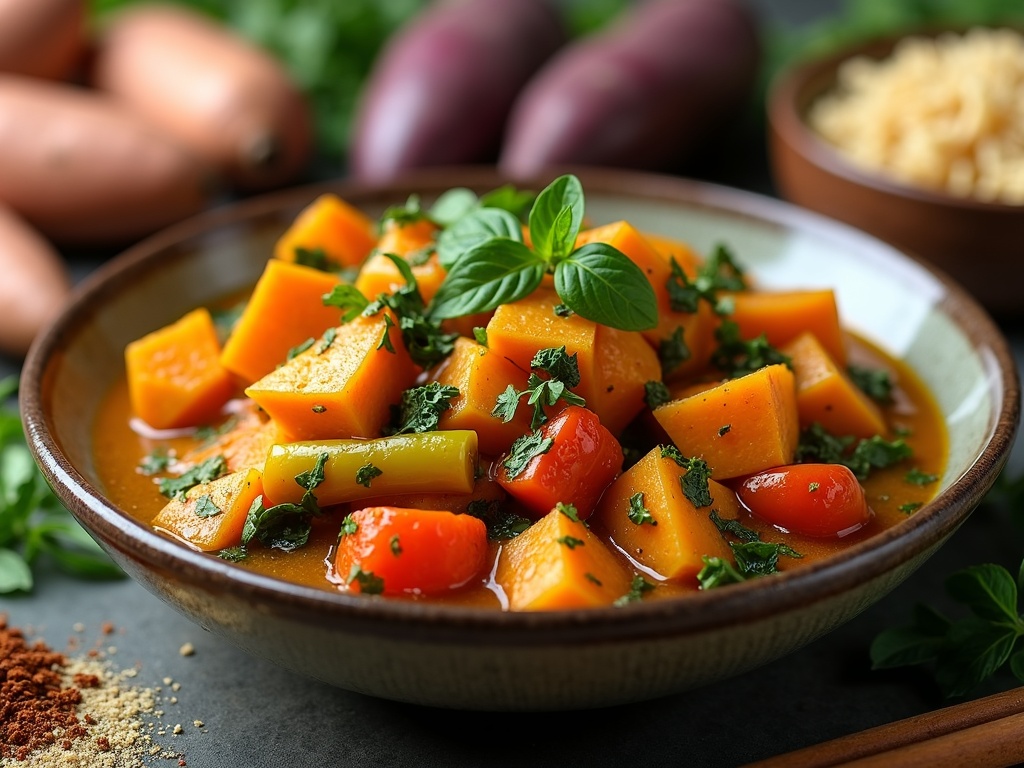
Quick and Easy Curry Creation
Creating a delicious sweet potato curry doesn’t require hours in the kitchen or fancy equipment. I’ve perfected a method that delivers impressive results in under 30 minutes. The secret lies in understanding a few key principles about ingredients and technique.
Essential Ingredients & Preparation
The foundation of any good sweet potato curry starts with quality ingredients. Here’s what I gather before cooking:
- 2 large sweet potatoes (peeled and cubed into 1-inch pieces)
- 1 can (14oz) coconut milk
- 1 medium onion (finely diced)
- 3-4 garlic cloves (minced)
- 1-inch piece of ginger (grated)
- 2-3 tablespoons curry powder
I begin by prepping all ingredients before heating any pan. This approach saves time and prevents burning aromatics while I’m busy chopping potatoes. After peeling and cubing the sweet potatoes into uniform pieces (crucial for even cooking), I heat a tablespoon of oil in a large pot over medium heat.
The aromatics go in first – onions cook until translucent (about 3-4 minutes), followed by garlic and ginger for another minute. This creates a flavorful base. I then add curry powder and toast it for 30 seconds until fragrant, which wakes up the spices and adds depth to the vegetable curry flavor.
Cooking Process & Customizations
Once the spices are fragrant, I add the sweet potato cubes, stirring to coat them evenly with the spice mixture. Pouring in the coconut milk plus about a cup of water creates enough liquid for the potatoes to simmer. After bringing to a gentle boil, I reduce heat, cover, and let simmer for 20-25 minutes until the sweet potatoes are fork-tender.
What makes this curry recipe special is its versatility. I often enhance the basic recipe with:
- Protein boosters: chickpeas or red lentils (add with the liquid)
- Vegetables: spinach (added in the last 2 minutes) or bell peppers (add with sweet potatoes)
- Flavor enhancers: a squeeze of lime juice just before serving
The spice level is completely adjustable. For a mild curry, stick with the basic curry powder. For medium heat, I add one finely chopped serrano pepper with the onions. And for those who enjoy intense spice, two Thai bird chilies create significant heat.
Getting the texture right makes all the difference between an average and exceptional curry. I’ve learned to watch the liquid levels carefully – if the curry seems too thick during cooking, I add water in small amounts (¼ cup at a time). Conversely, if it’s too thin after the sweet potatoes are tender, I simmer uncovered for a few extra minutes to reduce the liquid.
For the creamiest result, I sometimes mash about a quarter of the sweet potato pieces against the side of the pot with a wooden spoon. This thickens the curry sauce naturally while maintaining texture.
This sweet potato curry pairs wonderfully with fragrant rice dishes or flatbreads. For a complete meal with complementary flavors, I sometimes serve it alongside a tangy vegetable sambar.
The beauty of this recipe is that once you’ve mastered the basic technique, you can adapt it endlessly to suit your taste preferences and what’s available in your pantry. From start to finish, you’ll have a delicious, comforting meal ready in about 30 minutes – perfect for busy weeknights when you want something satisfying without spending hours in the kitchen.
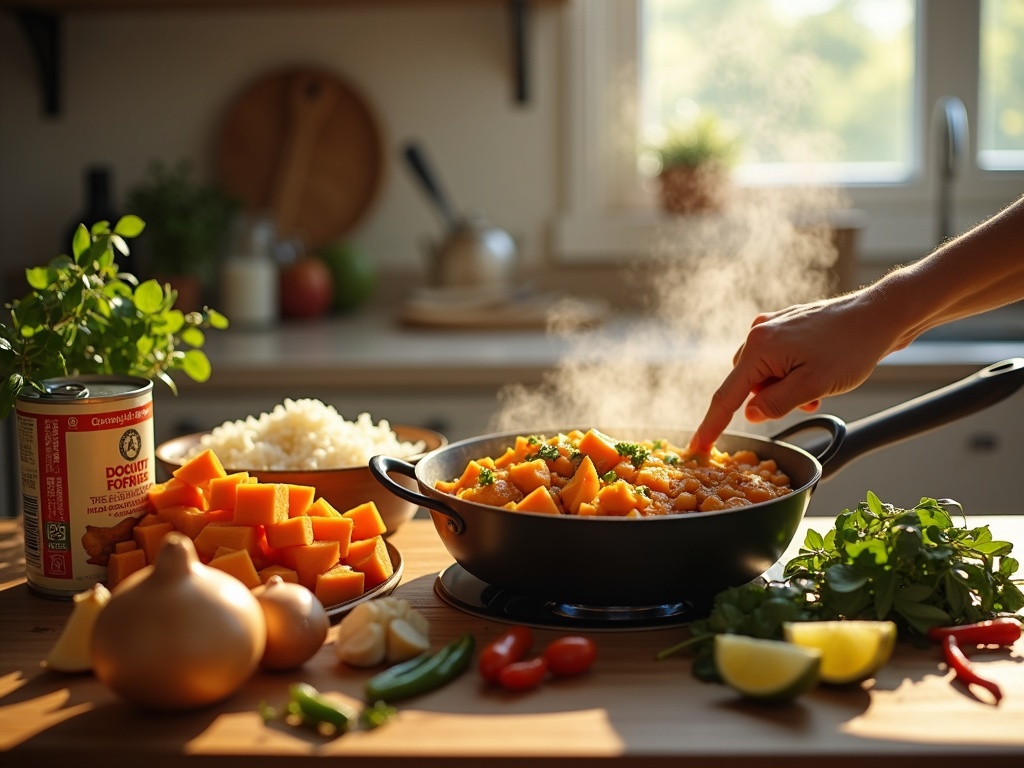
Global Curry Variations and History
Sweet potato curry enjoys remarkable popularity across several continents, with each region adding its unique twist to this versatile dish. Though the sweet potato itself originated in Central and South America over 5000 years ago, its integration into curry dishes happened much later as trade routes expanded and culinary traditions merged.
Regional Adaptations
In South India, sweet potato curry takes on a distinctive character with the addition of mustard seeds and curry leaves. The tempering process, where spices are heated in oil to release their flavors, creates a fragrant base that perfectly complements the natural sweetness of the tubers. This style often includes tamarind for tanginess, balancing the dish beautifully. South Indian curries like traditional sambar showcase similar spice profiles that work wonderfully with sweet potatoes.
Caribbean sweet potato curry represents another fascinating adaptation. Here, the dish incorporates coconut milk for creaminess and allspice for warmth, creating a uniquely tropical flavor profile. The addition of scotch bonnet peppers provides heat while still allowing the sweetness of the potatoes to shine through. This version often accompanies rice dishes similar to aromatic pulao for a complete meal.
Southeast Asian versions have their own character, typically featuring lemongrass, galangal, and lime leaves. These curries tend to balance sweet, sour, salty, and spicy elements in harmony with the sweet potato’s natural flavor. Thai and Malaysian variants often incorporate other vegetables alongside sweet potatoes for added texture and nutrition.
Cultural Significance
The variations in sweet potato curry recipes reflect local culinary traditions and available ingredients:
- In vegetarian-focused cultures like parts of India, sweet potato curry provides substantial nutrition and serves as a centerpiece in legume-based meals.
- Island nations incorporate seafood alongside sweet potatoes.
- Northern regions pair the curry with hearty grains.
- Tropical areas add local fruits like pineapple or mango.
What makes sweet potato curry truly special is its adaptability. Unlike more rigid dishes, it welcomes modification while maintaining its comforting essence. For a twist on the traditional, try adding cauliflower to your sweet potato curry for textural contrast and added nutritional benefits.
I’ve found that understanding these regional variations not only deepens appreciation for the dish but also provides inspiration for creating personalized versions at home that honor both tradition and innovation.
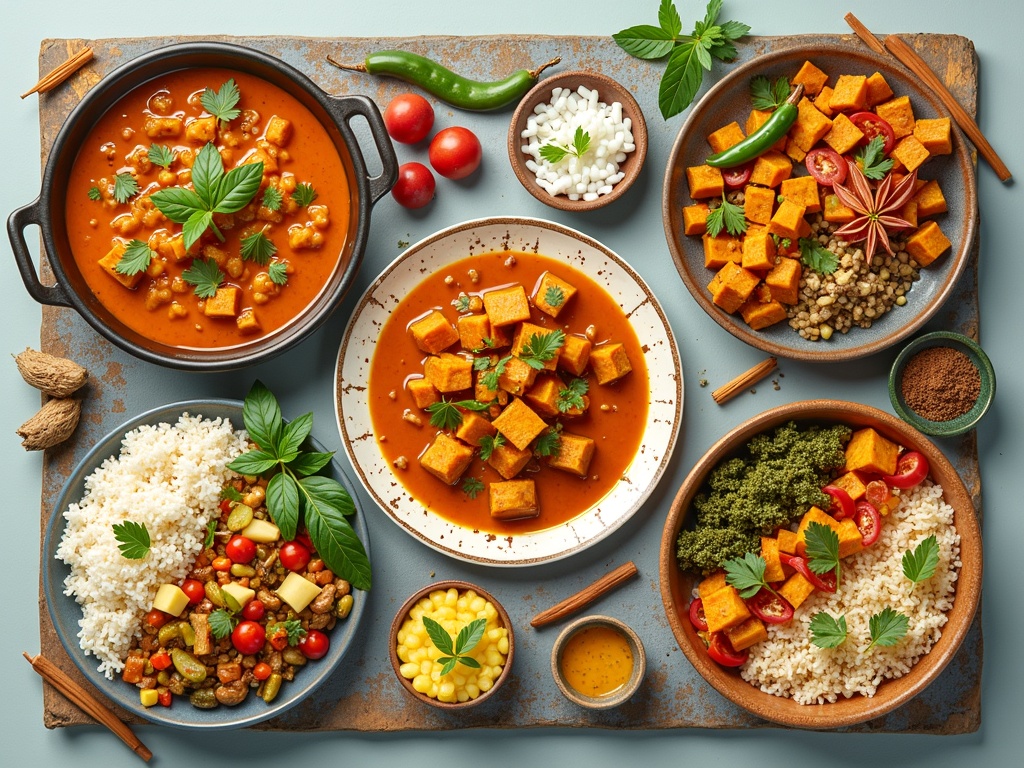
Shopping and Selection Guide
Sweet potato curry is a versatile dish that allows me to experiment with flavors while maintaining nutritional benefits. Finding the right ingredients makes all the difference in creating an authentic and delicious meal.
Selecting the Perfect Ingredients
Sweet potatoes are available year-round in most grocery stores, but their peak season runs from September through December. During these months, you’ll find them at their freshest and often at better prices. When shopping, I look for firm, smooth-skinned sweet potatoes without any soft spots, cracks, or discoloration. Medium-sized ones tend to cook more evenly in vegetable curry recipes.
For coconut milk, quality matters significantly. I recommend organic brands like Thai Kitchen and Native Forest, which offer a creamy texture without unnecessary additives. When reading labels, check for these key factors:
- Minimal ingredients (ideally just coconut and water)
- No added gums or stabilizers when possible
- BPA-free cans
- Higher fat content (around 14g per serving) for creamier curry dishes
Curry spices require careful selection too. Fresh spices make all the difference in your dahl or curry recipes. I look for:
- Whole spices when possible (they retain flavor longer)
- Vibrant colors (faded spices have lost potency)
- Strong aroma when opened
- Reputable spice brands or specialty stores
For specialty ingredients like specific curry powders or pastes, ethnic grocery stores offer authentic options at better prices than mainstream supermarkets. Asian and Indian markets are gold mines for finding ingredients like kaffir lime leaves, lemongrass, and various sambar masalas that elevate your curry.
Online specialty retailers have made finding these ingredients easier, particularly if you live in areas without diverse grocery options. Many also offer organic and fair-trade options that support sustainable farming practices.
Planning ahead by buying shelf-stable ingredients like coconut milk and spices in bulk can save money and ensure you’re always ready to create a delicious pulao or curry on short notice. Just store spices in airtight containers away from heat and light to maintain their potency.
Your Perfect Timing and Storage
Sweet potato curry isn’t just about the right blend of spices and cooking technique – timing and storage play crucial roles in maximizing flavor and convenience. I’ve learned through countless curry sessions that these elements can transform your vegetable curry experience from good to exceptional.
Seasonal Selection and Storage Strategies
October through December offers the freshest sweet potatoes in most regions, though they’re available year-round. These peak-season tubers deliver superior flavor and texture for your curry. When shopping, I look for firm sweet potatoes with smooth skin free from soft spots or sprouts.
Proper storage begins the moment you bring ingredients home. For optimal results:
- Sweet potatoes: Store in a cool, dark place (not the refrigerator) for up to 3-4 weeks. The pantry or a ventilated basket works perfectly.
- Onions and garlic: Keep in a dry, well-ventilated area away from potatoes, as they’ll make each other spoil faster.
- Fresh herbs: Wrap in slightly damp paper towels and refrigerate in a sealed container for up to 1 week.
- Spices: Store in airtight containers away from heat and direct sunlight to maintain potency for 6-12 months.
The curry paste or powder that forms the backbone of your cauliflower curry or sweet potato version typically lasts 2-3 months when refrigerated properly. I’ve found that coconut milk can be stored unopened for up to a year, but once opened, it should be used within 4-5 days.
Meal prep has saved me countless hours during busy weeks. I often prepare a large batch of sweet potato curry on weekends, similar to how I’d approach a sambar recipe, portioning it into individual containers. The curry actually improves after a day or two as flavors meld together – making it perfect for planning ahead.
For leftover curry, proper storage is straightforward but important. I transfer it to an airtight container once it has cooled (within two hours of cooking) and refrigerate promptly. This keeps your curry fresh for 3-4 days without quality loss. Glass containers work best as they don’t absorb the curry’s colors or flavors.
Freezing extends your curry’s life significantly when done correctly. I portion cooled curry into freezer-safe containers, leaving about an inch of headspace for expansion. These frozen portions remain excellent for up to 3 months – a lifesaver for busy evenings. For the best texture, I freeze the curry without rice, as pulao rice or other grains can be prepared fresh when needed.
When reheating, gentle methods preserve flavor and texture. For refrigerated curry, I use a saucepan over medium-low heat, stirring occasionally until it reaches 165°F (74°C). For frozen curry, I thaw overnight in the refrigerator before reheating, or use the defrost setting on my microwave followed by regular heating. Adding a splash of water, coconut milk, or vegetable broth revives the consistency if it’s thickened during storage.
The beauty of sweet potato curry lies partly in its adaptability – like a good dahl recipe, it maintains its charm through storage and reheating. I’ve found that garnishing with freshly chopped cilantro or a squeeze of lime after reheating brings back the vibrant flavors of a freshly made curry.
Seasonal Ingredient Pairings
Sweet potato curry offers incredible flexibility when it comes to adapting to seasonal ingredients. I’ve found that changing up the accompanying vegetables and proteins based on what’s fresh can transform this dish throughout the year.
Seasonal Vegetable and Protein Combinations
During spring, I love pairing sweet potatoes with tender vegetables that reflect the season’s freshness:
- Asparagus spears add a delicate texture
- Fresh green peas bring a pop of sweetness
- Baby spinach wilts perfectly into the curry
- Tofu or chicken complements these lighter vegetables
Summer brings an abundance of options that add vibrancy to your vegetable curry creation:
- Bell peppers in various colors add sweetness
- Zucchini and yellow squash provide gentle texture
- Fresh tomatoes enhance the curry base
- Grilled paneer or shrimp work beautifully as protein additions
Fall is when sweet potatoes truly shine, and I enhance them with:
- Cauliflower curry elements bring nutty flavors
- Butternut squash intensifies the earthy sweetness
- Mushrooms add umami depth
- Lamb or chickpeas provide substantial protein options
Winter calls for heartier additions:
- Kale or collard greens add nutritional density
- Carrots bring complementary sweetness
- Red cabbage provides color and crunch
- Lentils from a simple dahl recipe can be incorporated for protein
The spice profiles can shift with the seasons too. Lighter profiles with cardamom, coriander, and turmeric work well in spring and summer. Fall and winter benefit from warming garam masala, cinnamon, and cloves.
Regional variations also influence seasonal adaptations. Coastal regions might incorporate coconut milk year-round, while northern variations might lean into pulao recipe influences with whole spices and dried fruits in colder months.
When certain ingredients aren’t available, I’ve had success with these substitutions:
- Sweet potatoes → butternut squash or pumpkin
- Fresh tomatoes → canned tomatoes or tomato paste
- Fresh chilies → dried chili flakes or cayenne
- Spinach → any leafy green like Swiss chard
The key to successful seasonal adaptation is maintaining balance in flavor and texture. If using winter vegetables that take longer to cook, I cut them smaller or pre-cook them slightly. For a complete meal experience, consider serving your curry with a sambar recipe on the side for additional flavor dimensions.
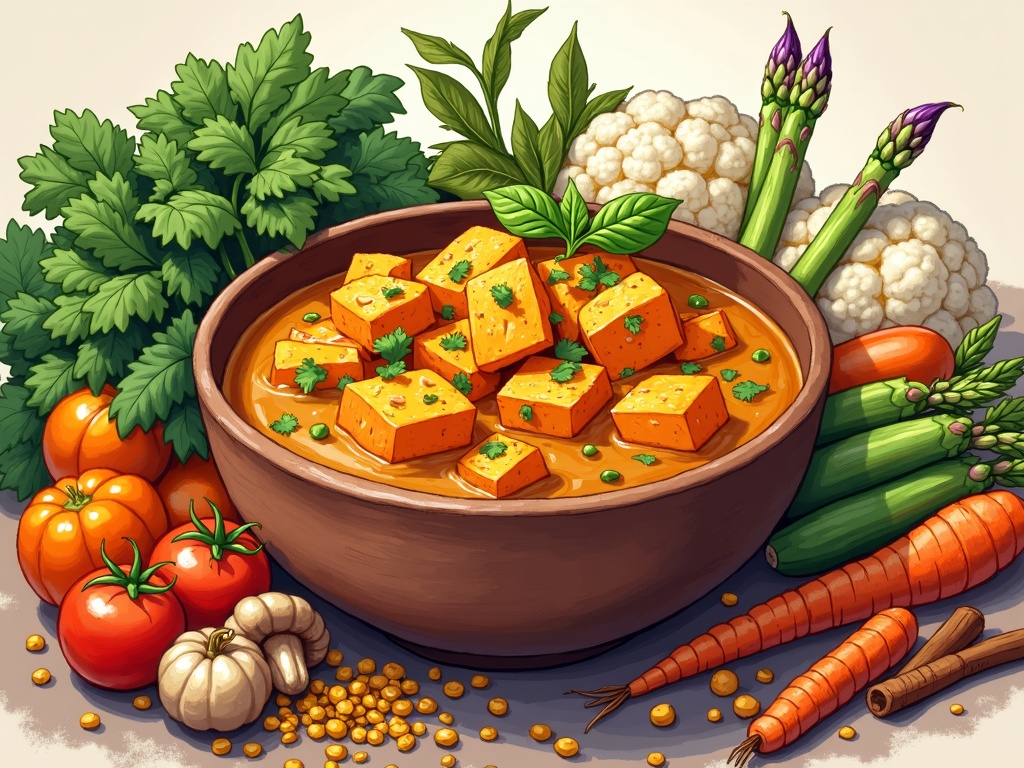
Sources:
Nutritional Composition of Sweet Potato
The Versatility of Sweet Potato in Various Cuisines
Health Benefits of Sweet Potatoes
Comparative Nutritional Value of Sweet Potatoes and Regular Potatoes
Culinary Uses of Sweet Potatoes Around The World

